Gaspar de Crayer stands as a significant, if sometimes overshadowed, figure in the rich tapestry of 17th-century Flemish Baroque painting. Born in Antwerp and active primarily in Brussels and Ghent, de Crayer carved out a prolific career, producing a vast oeuvre of altarpieces, religious narratives, and distinguished portraits. While often discussed in relation to his towering contemporaries, Peter Paul Rubens and Anthony van Dyck, de Crayer developed a distinct artistic voice characterized by its elegant compositions, refined colour palette, and profound emotional resonance, particularly in his religious works. His contributions were vital to the artistic landscape of the Spanish Netherlands during the Counter-Reformation, a period that demanded art of persuasive power and devotional depth.
Early Life and Artistic Formation in Antwerp
Gaspar de Crayer was born in Antwerp on November 18, 1584. His father, also named Gaspard de Crayer, was an art dealer, decorative painter, and illuminator, suggesting an early immersion in the world of art for the young Gaspar. This familial background likely provided him with initial exposure to artistic techniques and the business of art. While Antwerp was the bustling artistic hub of Flanders, dominated by the colossal talent of Peter Paul Rubens, de Crayer's formal training is traditionally linked to Raphael van Coxcie in Brussels. Raphael van Coxcie, son of the more famous Michiel Coxcie (sometimes dubbed the "Flemish Raphael" for his Italianate style), would have provided a solid, if somewhat conservative, grounding in the traditions of Flemish painting.
However, the artistic air in Antwerp during de Crayer's formative years was electric with innovation. The return of Rubens from Italy in 1608 had revolutionized painting in the Southern Netherlands. Rubens brought with him a dynamic synthesis of Italian Renaissance grandeur, particularly influenced by masters like Titian, Tintoretto, and Veronese, and the dramatic intensity of Caravaggio, all fused with a uniquely Flemish vitality. It is almost certain that the young de Crayer would have been profoundly aware of, and deeply impressed by, the works emerging from Rubens's studio. Though direct pupilage under Rubens is not definitively documented and often debated, the stylistic impact of the older master on de Crayer's subsequent work is undeniable.
Rise to Prominence in Brussels
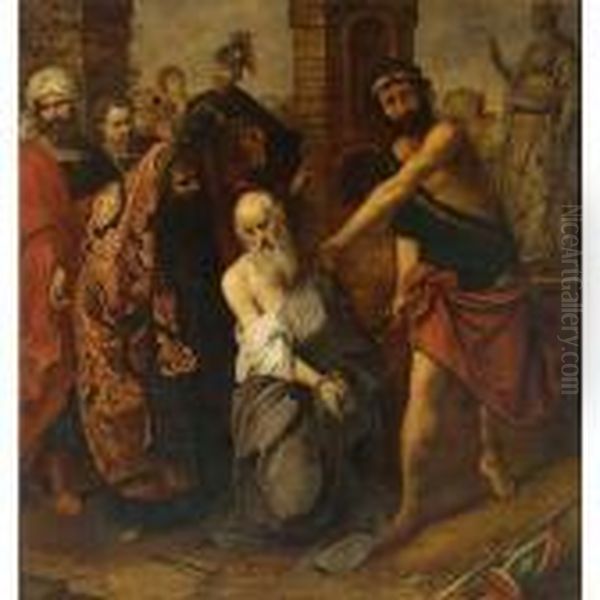
By 1607, Gaspar de Crayer had moved to Brussels, the administrative capital of the Spanish Netherlands. He was registered as a master in the Brussels Guild of Saint Luke in that year and served as its dean from 1614 to 1616. This indicates a swift establishment and recognition of his talents within the artistic community of the city. Brussels, as the seat of the court of the Archdukes Albert and Isabella, offered significant patronage opportunities. De Crayer's skill and diligence did not go unnoticed, and he began to receive important commissions for altarpieces for churches and monasteries, as well as portraits for the nobility and affluent bourgeoisie.
His reputation grew steadily, and he became a favored painter of the governors of the Spanish Netherlands. He was appointed court painter to the Cardinal-Infante Ferdinand of Austria, brother of King Philip IV of Spain, who became governor in 1635. This prestigious position solidified his status and ensured a steady stream of high-profile commissions. De Crayer's ability to create large-scale, dignified, and emotionally engaging religious works perfectly suited the needs of the Counter-Reformation Church, which sought to reaffirm its doctrines and inspire piety through art. His portraits, too, were highly regarded for their refined elegance and psychological insight, capturing the status and character of his sitters.
During his Brussels period, de Crayer's style matured. While the influence of Rubens remained a constant, de Crayer's figures often possessed a more slender elegance, and his compositions, though dynamic, could exhibit a greater sense of calm and classical balance. His palette, while rich, often favored cooler tones and more subtle harmonies compared to the fiery exuberance of Rubens. He also demonstrated a remarkable capacity for work, managing a productive studio that helped him fulfill numerous large-scale commissions.
Artistic Style: Influences and Individuality
Gaspar de Crayer's artistic style is a fascinating blend of prevailing Flemish Baroque trends and his own distinct sensibilities. The most significant influence, undoubtedly, was Peter Paul Rubens. De Crayer adopted Rubens's dynamic compositional structures, his use of robust, fleshy figures, and his dramatic interplay of light and shadow. Works like The Raising of Lazarus or The Miraculous Draught of Fishes clearly show this Rubenesque foundation in their energetic movement and monumental scale. However, de Crayer often tempered Rubens's high drama with a more restrained emotional tenor and a preference for clearer, more delineated forms.
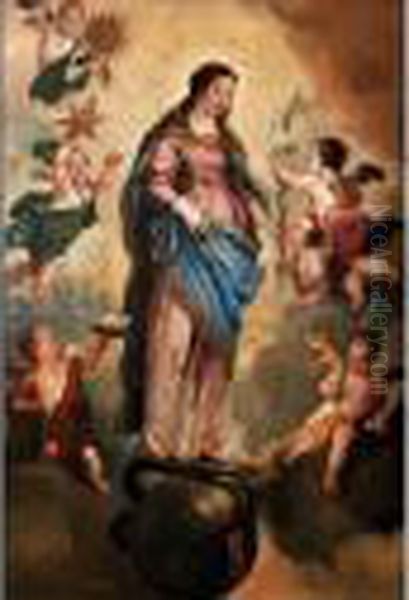
Another key influence was Anthony van Dyck, particularly in the realm of portraiture. Van Dyck, himself a brilliant pupil of Rubens, developed an unparalleled elegance and psychological acuity in his portraits. De Crayer's portraits, such as the commanding Portrait of Cardinal-Infante Ferdinand of Austria on Horseback, echo Van Dyck's sophisticated portrayal of aristocratic sitters, capturing their dignity and authority with a refined touch. De Crayer, in fact, painted a portrait of Van Dyck, and Van Dyck is known to have had one of de Crayer's compositions, Roman Charity, engraved, indicating mutual respect.
Beyond his Flemish contemporaries, de Crayer's art also shows an awareness of the Venetian school, particularly the work of Titian and Paolo Veronese. This is evident in his rich color harmonies, the opulent rendering of fabrics, and the grandeur of his multi-figure compositions. Some scholars suggest that his later works, particularly those from his Ghent period, exhibit a softening of his palette and a more lyrical quality, perhaps reflecting a deeper engagement with Venetian aesthetics or a personal evolution towards a more serene mode of expression. He was also known to have studied and even imitated works by Titian, a common practice for artists seeking to master the techniques of the greats.
The spirit of the Counter-Reformation is a pervasive element in de Crayer's religious paintings. His altarpieces were designed to instruct, inspire, and move the faithful. Works like The Martyrdom of St. Blaise or The Lamentation over the Dead Christ are imbued with a palpable sense of piety and pathos, encouraging an empathetic response from the viewer. He skillfully depicted scenes of martyrdom, miracles, and divine apparitions, reinforcing Catholic dogma and promoting devotion to the saints.
Major Works and Thematic Concerns
Gaspar de Crayer's oeuvre is vast, encompassing numerous altarpieces, mythological scenes, and portraits. Among his most celebrated religious works is The Death of the Virgin Mary, now in the Prado Museum, Madrid. This painting showcases his ability to handle a complex, multi-figure composition with clarity and emotional depth. The grief of the apostles is palpable, yet the overall scene maintains a sense of solemn dignity, with the Virgin depicted in a serene, idealized manner. The lighting is carefully managed to highlight the central figures and create a spiritual ambiance.
Another significant work is The Judgment of Solomon, located in the Museum of Fine Arts, Ghent. This piece demonstrates his skill in narrative painting, capturing the dramatic tension of the biblical story. The figures are expressive, and the composition is balanced yet dynamic, guiding the viewer's eye to the central conflict and Solomon's wise resolution. The rich rendering of textures and the strong characterization of the figures are hallmarks of de Crayer's style.
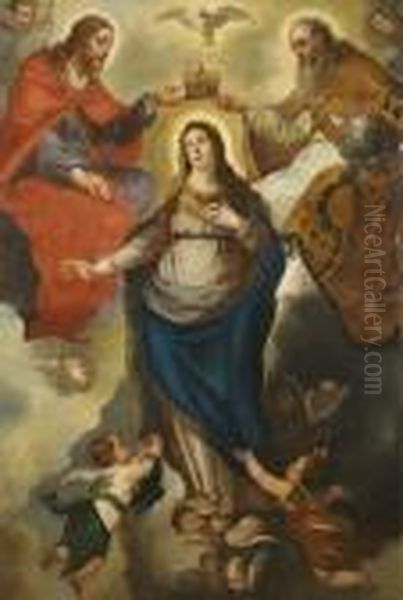
His Ecce Homo (c. 1640-1656) is a powerful depiction of Christ presented to the crowd, conveying both suffering and divine resignation. The painting is notable for its dramatic lighting, reminiscent of Caravaggio's tenebrism but filtered through a Flemish sensibility, and its focus on the emotional intensity of the moment. Similarly, Christ and the Adulteress, housed in Antwerp Cathedral, displays his mastery of complex figural arrangements and his ability to convey a narrative with clarity and moral weight. The contrast between the accusatory crowd and Christ's compassionate demeanor is skillfully rendered.
In portraiture, the Portrait of Cardinal-Infante Ferdinand of Austria on Horseback is a standout. Equestrian portraits were a powerful symbol of authority and status, and de Crayer rises to the occasion, depicting the Cardinal-Infante with regal bearing against a dynamic landscape. The meticulous attention to the details of armor and attire, combined with a strong likeness, makes it a compelling image of power. He also painted numerous other portraits of ecclesiastical figures, nobles, and prominent citizens, all characterized by their dignified presentation and insightful characterization.
Other notable works include The Adoration of the Shepherds, The Four Crowned Martyrs, and numerous depictions of saints such as St. Catherine, St. Augustine, and St. Norbert. Many of his altarpieces remain in the churches and chapels for which they were originally commissioned, particularly in Flanders, allowing them to be seen in their intended devotional context.
The Ghent Period: A Prolific Final Chapter
Around 1664, late in his life, Gaspar de Crayer moved from Brussels to Ghent. Despite his advanced age (he was nearly eighty), this move marked the beginning of another incredibly productive period. In Ghent, he continued to receive major commissions and maintained a busy workshop. It is a testament to his enduring vitality and reputation that he remained so active. Some of his most significant works were produced during these final years.
One of the reasons for his move might have been the abundance of commissions available in Ghent, particularly for the city's many churches and monastic orders. His style, by this time fully matured, was highly sought after. His workshop in Ghent was well-organized, enabling him to produce a remarkable number of large-scale paintings. Among the important works from this period is The Martyrdom of St. Blaise for the high altar of the Abbey of St. Peter in Ghent (now in the Museum of Fine Arts, Ghent), a powerful and dramatic composition that exemplifies his late style.
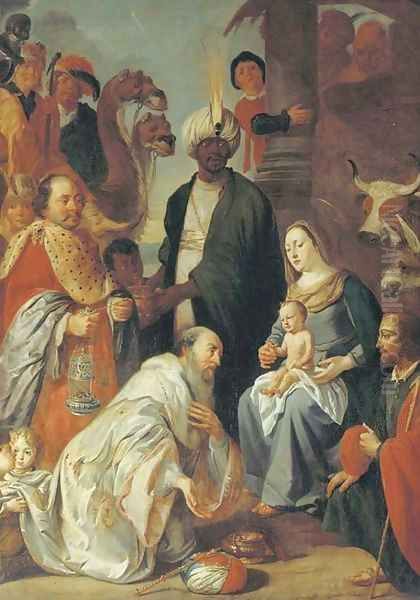
His late works often exhibit a slightly cooler palette and a more refined, almost ethereal quality in the depiction of figures, while still retaining the compositional dynamism and emotional depth that characterized his earlier paintings. He continued to work with remarkable energy until his death in Ghent on January 27, 1669, at the age of 84. His long life and sustained productivity meant that he left an indelible mark on the artistic landscape of Ghent, much as he had in Brussels.
Collaborations, Workshop, and Influence on Other Artists
Like many successful Baroque masters, Gaspar de Crayer maintained an active workshop to help him manage the large number of commissions he received, especially for monumental altarpieces. While the extent of workshop participation could vary, it was common for assistants to work on backgrounds, drapery, or less critical parts of a composition, with the master focusing on the principal figures and the final touches. This collaborative approach was essential for the prolific output demanded by patrons.
De Crayer is also known to have collaborated with specialist painters, particularly for landscape elements in some of his works. For instance, sources mention collaborations with landscape painters such as Lodewijk de Vadder and Lucas Achtschellinck. In such arrangements, de Crayer would typically paint the figures, while the collaborator would provide the landscape setting, a common practice that allowed each artist to contribute their specific expertise.
Gaspar de Crayer's influence extended to a number of pupils and followers. One of his most notable pupils was Jan van Cleve (also known as Jan van Cleef), who worked with de Crayer in Ghent and continued his master's style, particularly in religious paintings. Van Cleve inherited de Crayer's capacity for large-scale compositions and his devotional sensibility. Through his students and the widespread dissemination of his works, de Crayer's artistic influence was felt throughout Flanders and even beyond. His paintings were sought after by patrons in Spain and Germany, reflecting his international reputation.
While he may not have had the revolutionary impact of Rubens or the international courtly fame of Van Dyck, de Crayer was a highly respected and successful artist who played a crucial role in propagating the Flemish Baroque style. His contemporaries certainly held him in high regard. Rubens himself is famously quoted as saying, "Crayer, nobody will surpass you," a testament to the esteem in which he was held by the leading master of the age.
Relationship with Contemporaries: Rubens, Van Dyck, and Jordaens
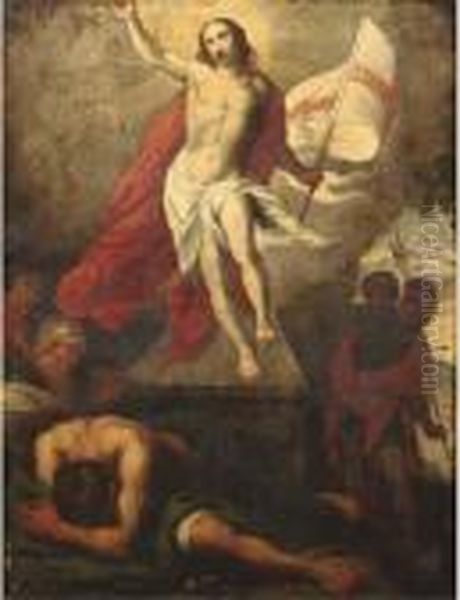
Gaspar de Crayer's career unfolded in the shadow of, yet in productive dialogue with, the giants of Flemish Baroque art. His relationship with Peter Paul Rubens was one of profound artistic influence and mutual respect. While not a direct pupil in the formal sense, de Crayer absorbed many of Rubens's stylistic innovations: the dynamic compositions, the robust figures, the rich color, and the dramatic intensity. However, de Crayer adapted these elements to his own temperament, often resulting in works that were more serene or melancholic than Rubens's exuberant creations. The anecdote of Rubens praising de Crayer underscores the high esteem the older master had for his talents.
With Anthony van Dyck, the connection was perhaps more one of shared sensibilities in portraiture and a mutual professional regard. Both artists excelled at capturing the elegance and psychological depth of their sitters. Van Dyck's refined style undoubtedly influenced de Crayer's approach to portrait painting. The fact that Van Dyck commissioned a portrait from de Crayer and also had one of de Crayer's compositions engraved speaks to a collegial relationship. They were key figures in defining the sophisticated portraiture of the Flemish Baroque.
Jacob Jordaens, another major figure of the Antwerp school and a contemporary of de Crayer, offered a different artistic path. While also influenced by Rubens, Jordaens developed a more robust, earthy, and often boisterous style, particularly in his genre scenes and mythological paintings. De Crayer's work, by contrast, generally maintained a greater degree of classical restraint and aristocratic elegance, especially in his religious and courtly commissions. While their styles differed, both Jordaens and de Crayer contributed significantly to the diversity and richness of Flemish painting in this era, alongside other notable Antwerp painters like the animal specialist Frans Snyders or the meticulous flower painter Jan Brueghel the Elder, who often collaborated with Rubens.
The broader artistic context also included the pervasive, though often indirect, influence of Italian masters like Caravaggio, whose dramatic use of chiaroscuro resonated throughout Europe, and the Venetian masters Titian, Tintoretto, and Veronese, whose colorism and compositional grandeur were foundational for the Baroque. De Crayer, like his contemporaries, navigated these influences, forging a personal style that met the demands of his patrons and expressed his own artistic vision. He also worked for patrons who employed other great artists, such as the Cardinal-Infante Ferdinand, who was also famously painted by Diego Velázquez in Spain.
Lesser-Known Aspects and Anecdotes
Beyond his major commissions and stylistic development, a few anecdotes and lesser-known facts add color to Gaspar de Crayer's biography. His long life, spanning 84 years, was remarkable for the era and allowed him to witness significant shifts in artistic tastes and to maintain a productive career over many decades. This longevity also meant he outlived many of his contemporaries, including Rubens and Van Dyck, becoming one of the last great representatives of the initial wave of Flemish Baroque masters.
His connection to his hometown of Antwerp remained, even while he was based in Brussels and later Ghent. He continued to receive commissions from Antwerp patrons and maintained ties with the artistic community there. This reflects the interconnectedness of the major artistic centers in Flanders.
The story of Van Dyck commissioning his portrait from de Crayer is an interesting one, suggesting that even an artist of Van Dyck's stature recognized and valued de Crayer's skill in portraiture. Similarly, Van Dyck's involvement in the engraving of de Crayer's Roman Charity indicates that de Crayer's compositions were considered worthy of wider dissemination through prints, a common way for artists' fame to spread.
De Crayer's adaptability is also noteworthy. While deeply influenced by Rubens, he was not merely an imitator. He absorbed lessons from various sources, including the Venetian school and potentially earlier Flemish masters, and synthesized them into a style that was recognizably his own. His willingness to study and even copy works by masters like Titian demonstrates a commitment to continuous learning and refinement of his craft. This practice was not uncommon; artists like Rubens himself extensively copied Italian masters as part of their education and ongoing artistic development.
Legacy and Enduring Significance
Gaspar de Crayer's legacy is that of a highly accomplished and prolific master of the Flemish Baroque. He was a pivotal figure in the artistic life of Brussels and Ghent, fulfilling numerous prestigious commissions for church and state. His altarpieces played a significant role in the visual culture of the Counter-Reformation in the Spanish Netherlands, inspiring devotion and reinforcing Catholic doctrine through their grandeur, emotional power, and narrative clarity.
His portraits provide a valuable record of the leading figures of his time, rendered with an elegance and psychological insight that places him among the foremost portraitists of the era. While perhaps not possessing the revolutionary genius of Rubens or the dazzling international success of Van Dyck, de Crayer carved out a distinguished career and produced an oeuvre of consistently high quality. He successfully navigated the artistic currents of his time, absorbing key influences while developing a personal style characterized by its refined compositions, harmonious colors, and dignified emotional expression.
His influence on his pupils, such as Jan van Cleve, ensured the continuation of his artistic approach into the next generation. Today, his works are found in major museums and churches across Europe, including the Prado in Madrid, the Louvre in Paris, the Royal Museums of Fine Arts of Belgium in Brussels, and the Museum of Fine Arts in Ghent, as well as numerous ecclesiastical collections. Gaspar de Crayer remains an essential figure for understanding the breadth and depth of Flemish Baroque painting, a testament to his skill, diligence, and enduring artistic vision. His contribution, alongside those of other masters like Justus van Egmont or Theodoor van Thulden (both pupils of Rubens who also achieved considerable success), helps to paint a fuller picture of this extraordinarily rich period in art history.